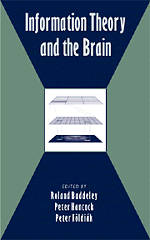Book contents
- Frontmatter
- Contents
- List of Contributors
- Preface
- 1 Introductory Information Theory and the Brain
- Part One Biological Networks
- 2 Problems and Solutions in Early Visual Processing
- 3 Coding Efficiency and the Metabolic Cost of Sensory and Neural Information
- 4 Coding Third-Order Image Structure
- Part Two Information Theory and Artificial Networks
- Part Three Information Theory and Psychology
- Part Four Formal Analysis
- Bibliography
- Index
3 - Coding Efficiency and the Metabolic Cost of Sensory and Neural Information
from Part One - Biological Networks
Published online by Cambridge University Press: 04 May 2010
- Frontmatter
- Contents
- List of Contributors
- Preface
- 1 Introductory Information Theory and the Brain
- Part One Biological Networks
- 2 Problems and Solutions in Early Visual Processing
- 3 Coding Efficiency and the Metabolic Cost of Sensory and Neural Information
- 4 Coding Third-Order Image Structure
- Part Two Information Theory and Artificial Networks
- Part Three Information Theory and Psychology
- Part Four Formal Analysis
- Bibliography
- Index
Summary
Introduction
This chapter examines coding efficiency in the light of our recent analysis of the metabolic costs of neural information. We start by reviewing the relevance of coding efficiency, as illustrated by work on the blowfly retina, and subsequently on mammalian visual systems. We then present the first results from a new endeavour, again in the blowfly retina. We demonstrate that the acquisition and transmission of information demands a high metabolic price. To encode and transmit a single bit of information costs a blowfly photo-receptor or a retinal interneuron millions of ATP molecules, but the cost of transmission across a single chemical synapse is significantly less. This difference suggests a fundamental relationship between bandwidth, signal-to-noise ratio and metabolic cost in neurons that favours sparse coding by making it more economical to send bits through a channel of low capacity. We also consider different modes of neural signalling. Action potentials appear to be as costly as analogue codes and this suggests that a major reason for employing action potentials over short distances in the central nervous system is the suppression of synaptic noise in convergent circuits. Our derivation of the relationship between energy expended and the useful work done by a neural system leads us to explore the molecular basis of coding. We suggest that the representation of information by arrays of protein molecules is relatively cheap – it is transmission through cellular systems that makes information costly. Finally, we demonstrate that the cost of fuelling and maintaining the retina makes significant demands on a blowfly's energy budget.
- Type
- Chapter
- Information
- Information Theory and the Brain , pp. 41 - 61Publisher: Cambridge University PressPrint publication year: 2000
- 6
- Cited by

